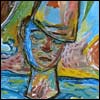They shall eat the flesh [of the Passover offering] on that night, roasted in fire, with matzot and bitter herbs. Do not eat of it half-done, or cooked or boiled in water; only roasted in fire
Exodus 12:8–9
We experience life as an endless chain of urges and strivings. We desire something, agonize over our lack of it, and expend our energies and resources in pursuit of it. And when our goal is actually attained, our pleasure and satisfaction are short-lived: already the next striving is forming in our hearts, already the fire of desire is consuming our lives.
We might, at times, envy the tranquility of those who are free of ambition, but it is the relentless seekers whom we admire and emulate. In our own experience, we look upon our periods of agitated quest as the high points of our lives. For we sense that while the tranquil person is at peace with himself, the striving person is relating to something greater than the self, something more than the here and now.
Three Offerings
In the twelfth chapter of Exodus, G‑d communicates to Moses the laws of the korban pesach, the Passover offering.
On the whole, the Torah is a pragmatic document. The events it describes are almost always physical events, and the mitzvot it commands are for the most part physical actions. But the Kabbalists and the chassidic masters insist that the Torah’s every word also relates to the spiritual dynamics of our lives. Each law of Torah—each organ and limb of its body—has its corresponding element in the soul of Torah.
The same is true of the laws of the Passover offering. In addition to their practical observance, they also instruct and address the inner life of our soul. But before we can discuss some of the spiritual applications of the korban pesach, we need to take a more detailed look at its practical laws.
When the Holy Temple stood in Jerusalem, every Jewish household, or group of smaller households, would bring a lamb or kid to the Temple on the fourteenth of Nissan, the day preceding the festival of Passover. The lamb would be slaughtered in the Temple courtyard, its blood would be sprinkled on the altar, and certain portions of it would be burned atop the altar. It would then be roasted on a spit over a fire. That night—the first night of Passover—its meat would be eaten with matzah and maror (bitter herbs), which together constitute the three staples of the Seder. (Today the meat of the Passover offering is represented at the Seder by the afikoman, a piece of matzah eaten at the end of the meal.)
Various types of korbanot were offered in the Holy Temple, but the Passover offering was unique in many ways, for it was governed by a set of laws that applied to no other offering. Some of these differences are specified in the fifth chapter of the Talmudic tractate of Zevachim, where the Talmud contrasts the Passover offering with two other korbanot—the firstborn offering (bechor) and the tithe offering (maaser):
The firstborn, tithe and Passover offerings are kodashim kallim. They can be slaughtered anywhere in the Temple courtyard, and their blood requires only one sprinkling, as long as it is directed toward the foundation of the altar. They differ, however, in how they are to be eaten. The firstborn offering is eaten by the priests, the tithe offering by anyone; both can be eaten throughout the city [of Jerusalem], in any form of food preparation, for two days and one night. The Passover offering can be eaten only at night, and only up to midnight, and only by those registered for it, and only roasted by fire. (Talmud, Zevachim 56b)
To briefly explain: The Torah commands the Jew to bring the firstborn of his cattle or sheep as an offering to G‑d. Also to be offered is a tithe of the animals born in the herd or flock (once a year, the year’s yield was herded into a pen, and the animals let out one at a time; every tenth animal to emerge was marked and pronounced holy to G‑d, and brought as an offering). The firstborn, tithe and Passover offerings all belong to a class of korbanot called kodashim kallim, and they resemble each other in the procedures of their offering upon the altar; but the rules pertaining to the eating of the Passover offering differ from those relating to the first two.
The firstborn and the tithe offerings can be eaten for two days and a night (on the day it was offered, on the following night, and on the following day until sunset), while the Passover offering can be eaten only on the night following its offering, and only until midnight. Another difference is that the firstborn and the tithe offerings can be prepared in any way the eater desires—boiled, stewed, baked, roasted, etc.—while the Passover offering has to be roasted on a spit over the fire, and cannot be prepared in any other way (not even as a pot roast cooked in its own juices with no other liquid added).
All these details—the laws of the firstborn, tithe and Passover offerings, and the differences between them—have their counterparts in the inner life of the soul.
First, Last and Over
The teachings of Kabbalah describe our world as founded upon ten divine attributes (sefirot) from which derive the spiritual form and substance of reality. Thus, the number ten represents the seder hishtalshelut (literally, “order of evolution”)—the spiritual order of things that G‑d instituted in His creation. “Firstborn” represents chochmah, the first and loftiest phase of the seder hishtalshelut; “tithe” refers to malchut, the last and lowest of the order. (Accordingly, the firstborn offering was eaten by the kohanim, who represent the higher, more spiritual callings of life, while the tithe offering was eaten by the farmer who brought it, representing the lowest, or most material, stratum of creation.) Together, the first and the tenth embrace the totality of the created reality.
Passover, as its name indicates, relates to that which transcends seder hishtalshelut, that which overleaps the standard processes of creation. The Passover offering is so named in attestation of the fact that G‑d leaped over the homes of the Jewish firstborn when He killed all Egyptian firstborn on the night of the Exodus, despite the fact that by all standard criteria the Jews were no more deserving of life than the Egyptians. Passover is G‑d’s disregarding of the very rules by which He ordered His world, and our reciprocation of His deed by rising above the dictates of nature and normalcy in our devotion to Him.
This explains the difference in how the Passover offering is eaten, as opposed to the firstborn and tithe offerings.
As we noted in the opening lines of this essay, life can be viewed as a cycle of striving and realization, yearning and gratification. The common metaphors for these two states are fire and water. Fire connotes thirst and upward striving; water suggests settling down and satiation.
A normal life—life as defined by the “order of evolution” from chochmah to malchut—is nourished by both fire and water. Some meals are cooked steeped in the water of contentment; others have lesser degrees of liquid to temper the fire of life; occasionally, one even partakes of a roast—a spurt of utter striving, of desire unsatiated by a single drop of gratification.
The Passover offering, however, can be experienced only one way—roasted on the fire. When a soul reaches for G‑d—not for the glimmers of divinity to be found within creation and experienced by conventional spiritual endeavor, but for G‑d Himself, as He transcends existence and reality—it is utterly consumed by an unceasing desire. For man can never capture anything of the divine essence. He can only strive for it, his soul a pure fire, with nary a drop of water to slake his thirst, without even a pot to contain his fervor.
Nighttime Meal
The firstborn and tithe offerings were eaten for two days and a night. The Passover offering was eaten only at night.
In the course of our history we have experienced days of divine light, as well as nights of spiritual darkness. Generally speaking, there were two daytime eras—the periods in which the first, and then the second, Beit Hamikdash manifested the divine presence in our world. Between these two days was a brief night—the seventy-year Babylonian galut, when the Holy Temple lay in ruins and the people of Israel were exiled from the Holy Land.1 Following the sunset of the second day, we were plunged into the blackest of nights—into our current centuries-long galut, rife with suffering and persecution, confounded by doubt and spiritual dissonance, and marked by the near-total concealment of the face of G‑d.
A normal relationship with G‑d could be had only in the “two days and a night” that preceded our present galut. These were times in which G‑d showed Himself to man—even in Babylon we had prophets and other expressions of divine immanence. But when the sun set on the second day, the flesh of the firstborn and tithe offerings could no longer be eaten. No longer could the divine truth be experienced within the workings of nature or accessed by the conventional processes of spiritual endeavor. No longer could man experience gratification in his spiritual life, for a glimpse of the divine had become an elusive dream.
In this night of nights, man’s striving for the divine is an unquenchable fire, an unrealizable yearning, an unconsummatable love. But for that very reason, it is deeper and truer than the fire-and-water concoctions of the past. In this night of nights, our yearning for G‑d is not focused upon first or tenth attributes, or filtered through orders of evolution. In this night of nights, our yearning for G‑d is not mitigated by plateaus of gratification. It passes over all systems and processes, to strive for the very essence of G‑d—an endless striving for the most endless of objectives.







Join the Discussion